By Milton J. Elliott III
When the call came that morning, it was not unlike the 25 times previously when they had flown, or all those other times when weather intervened and postponement was ordered.
The door to the Nissen hut bangs open, the dim center-ceiling bulb winks to life, heavy footsteps, a grasp and shake of the shoulder, “OK, sir, mission today, you’re scheduled to go, breakfast at 0500, briefing at 0530.” Hugh Hunter Hardwicke, Jr.’s, leaden eyes open imperceptibly, and to the figure silhouetted against the eerie glow he responds with the traditional, “Go away, just go away, OK.” Nonetheless, he sits up, stretches, scratches, yawns, slides from under his double thickness of wool blankets. He sort of scurries, perhaps shuffles, across the cold, wooden floor, stokes what remains of the fire, barely alive within the cast-iron relic cleverly disguised as a stove, and calls to his co-pilot, “Roll out, Flick, we’re on.”
“OK, Guys, Up, Up … and Away”
Gordon (Flick) Flickema’s first task of this new day is to rouse the other two officers of Hardwicke’s crew, navigator Moody (Jack) Jackson and bombardier Charles (Chick) Papousek, with his usual, dutiful, “OK, guys, up, up … and away.” They share this bleak, corrugated-steel, half-cylinder-shaped home with eight additional officers representing two other 568th Squadron crews, all of whom are grousing at the hour, the cold, the damp, the necessity of yet another mission. It is a little after 0400 when Hardwicke and others plod blurry-eyed to the nearby officers’ latrine and notice just a wisp of fog; not bad for late-November England, but that may change with inexplicable alacrity.
The 568th is one of four squadrons, each equipped with Boeing B-17G Flying Fortress bombers and their nine-man crews, plus a multitude of support units that comprise the 390th Bombardment Group (Heavy), within the command structure of the 13th Combat Wing, 3rd Air Division, Eighth Air Force. More than 1,500 officers and enlisted men, and a detachment of WAAFs (Women’s Army Air Forces personnel) share the base, officially Station 153, Framlingham, East Suffolk, East Anglia. The 390th acquired the facility, first used by the RAF, in July 1943. About a year later, Hardwicke and his “replacement crew No. 7” arrived and since then had acclimated themselves to the gently rolling farm country, fields neatly divided by hedgerows; here and there a square patch of woods, a shimmering pond.
Immediately to the west lay the railway station and quaint village of Parham; about three miles north, the larger village of Framlingham—imperturable tributes to a placid past, now juxtaposed with the tools and turbulence of war. Throughout, Station 153 retains a uniquely American flavor as recorded by a young English girl who lives nearby. “There are dogs everywhere, big ones, little ones, all colors, every kind, chasing trucks, riding in Jeeps, following the boys to eat, and always around somewhere.”
Hardwicke Dresses for Combat
There is little conversation as Hardwicke completes his early-morning ablutions and dresses: long johns, wool shirt, wool trousers, two pairs of wool socks, GI high-top shoes, and wool garrison cap with the silver bar of a first lieutenant pinned neatly on the left side. His A-2 leather flight jacket is complete with squadron insignia on the front, a snarling black panther riding earthward atop a bomb of burgundy against a white cloud/blue sky background. On the back are two rows of 10 bright yellow bombs and one of five, representing 25 combat missions, along with the name of their B-17, “Uninvited.”
As Hardwicke and other crew members emerge from the Nissen hut, canvas-draped heavy trucks are waiting to transport them to the combat mess. He clambers aboard and finds a place on one of the uncomfortable slatted wood benches that traverse the vehicle from front to rear. The truck lurches forward, and as the ride begins, Hardwicke is gripped by a rush of introspection.
He shares the universal conviction of all who face combat—he simply will do his job and return home unscathed. Yet now, right now, this sanguine notion is challenged by a cruel paradox not manifest in his Christian resolve and belief in a merciful God. He has seen B-17s disintegrate and fall from antiaircraft hits or incessant fighter attacks; he has mourned the dead, many of whom were his friends; and prayed for the missing and witnessed the empty cots, the vacant places at the combat mess and officers’ club. He has helped gather personal effects to be shipped home following the most dreaded of telegrams. He recalls the temporary shock when the number of missions needed for rotation Stateside was extended from 30 to 35, and the initial reaction of his crew. “We’ll never make it home now.”
The Many Ways To Die
There are so many ways to die. It could happen on the ground—a misplaced bomb, engine failure on takeoff, a blown tire. He has flown over the blazing remains of a B-17 whose crew did not have time to escape before disaster. It could happen during assembly over England, a slight miscalculation in blinding fog or heavy clouds and suddenly the plane above or below or on either wing is too close. There is no time to correct, a searing flash, a fireball, and pieces of airplane start to spiral into the English Channel, the North Sea, or the pastoral English countryside.
Once the bomber stream turns on its target heading, and today, thanks to the early call, it will be somewhere deep within Germany, safety resides only in one’s mind. Loss of oil pressure, oxygen malfunction, a runaway prop could lead to an abort, and not all aborts return safely.
Should these problems be overcome, or even better, simply not occur, there remains yet another factor, a hostile reception by the enemy, waiting to unleash its flak and fighters. Yet, as Hardwicke reflects, there are also many ways to live. The B-17G, modified to include a much-needed forward-firing chin turret, an improved tail gun and enclosed, staggered waist-gun positions, much greater ammunition capacity, and enhanced turbo-superchargers to increase high-altitude performance, is perhaps the most advanced and durable of all four-engine bombers in Europe. Its combat record and the battle damage it can sustain are the stuff of legend.
Hardwicke had come home on three engines after a flak hit over Zeitz in August and was forced to land in Italy about a month later when an antiaircraft shell cut a main fuselage spar just forward of the ball turret. In one of the most celebrated incidents, a B-17 was cut almost in half when it was rammed by a German Messerschmitt Me-109 fighter aft of the waist-gun positions. Miraculously, the “All American” made it home. Many B-17s that did survive were consigned to the graveyard. Their crews, those able to walk at least, returned to duty.
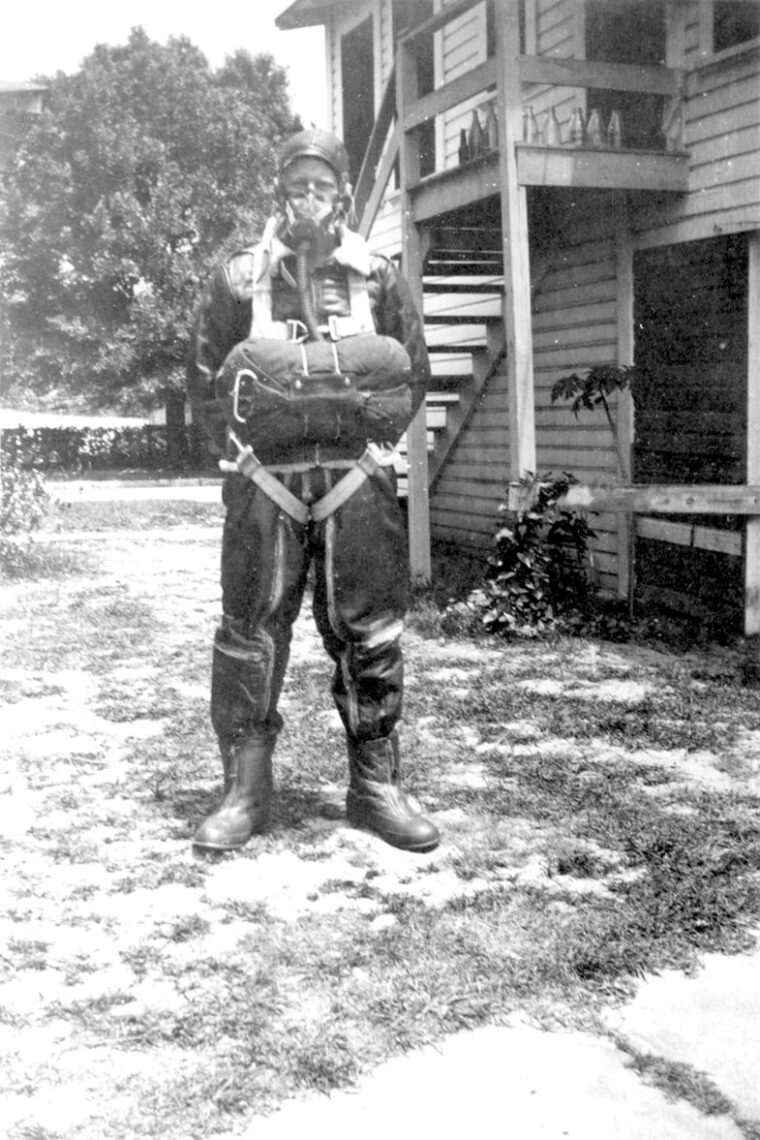
Commanding a Skilled, Able Crew
Hardwicke is quietly confident in the abilities of his crew. Each man is a skilled professional with a specific responsibility, part of a smoothly functioning team. Flickema, Jackson, and Papousek are seated next to him on the truck. Soon to join them will be Dale Weaver (radio operator/gunner), John Hammond (waist gunner), Denver (Pappy) Grogg (tail-gunner), Tom Downham (ball-turret gunner), and Waymon Avery (engineer and top-turret gunner). These fliers are from Texas, Maryland, Indiana, Michigan, Ohio, California, Illinois, and Hardwicke, Virginia. Their average age is 23, and Pappy Grogg, as his nickname suggests, is an elderly 29.
Hardwicke and his crew have trained and flown together for nearly a year and for the combat airman to shirk his duty, to fail a buddy, is unthinkable. Hardwicke, as commander, believes the least discipline is best. Treat the men fairly, and they will respond accordingly. Today, November 30, 1944, marks their 26th combat mission together.
As the truck bounces to a halt, Hardwicke’s sense of foreboding is crystallized by the date. Today is his second wedding anniversary. Not only that, but two months earlier, almost to the day, he turned 23. His grim speculation suddenly takes form, and for an instant he struggles with the very real possibility that he may not celebrate a 24th birthday or a third wedding anniversary. He and Gladys, his hometown sweetheart since spring 1941, had discussed and accepted the risk of wartime uncertainty. He had enlisted in the Army Air Corps in September 1942 and been told to await the call.
Meanwhile, the couple was wed on November 30, 1942, at Richmond’s Barton Heights Baptist Church and enjoyed their honeymoon in New York City. The call and his opportunity to fly—an abiding passion since childhood—came in March 1943. For the next 10 months, Hardwicke applied himself with purpose and tenacity to become an Army Air Corps pilot. In December, he was commissioned a second lieutenant, presented silver wings, and assigned to fly B-17s.
“Never Saw the Target … Wish to Hell We’d Get Some Good Weather”
Flickema nudges Hardwicke’s shoulder, “Come on, Hugh, let’s eat.” Jackson chuckles, “Wake up, Hugh, chow time.” Not to be remiss, Papousek adds, “OK, Hugh, move it.” All four slide from the truck and stroll into the combat mess, already alive with other crews and chatter. The serving line is short, fare basically the same.
Hardwicke assembles his plate, stainless steel flatware, napkin, and cup, and accepts a heaping spoonful of reconstituted eggs, four slices of crisp bacon, some well-browned toast. Coffee, hot and black, is the final ingredient as they find places at one of the long wooden tables, each equipped with a multitude of individual wooden chairs. Suspended from the ceiling a dozen or so shaded bulbs provide the sole source of illumination, enough to notice the many posters with a central pictorial and verbal theme: “It comes 5000 miles/Eat what you take … Don’t be a chow-hog/Take only what you eat … Eat what you take!” Discussion of a mission to the railroad marshaling yards at Hamm four days earlier elicits general agreement. “Heard the results were OK … had to drop through clouds … never saw the target … wish to hell we’d get some good weather.” Today’s mission was a matter of speculation. “Wonder where the hell they’re sending us today … what kind of opposition you think we’re gonna see … we were up early, expect it’ll be a long one.” Hardwicke checks his watch, it is 0520, about 10 minutes before briefing when these and many other questions will be answered.
Field Order No. 500, received the previous day at 2040 hours, confirmed an earlier phone alert from 3rd Air Division headquarters. It outlined in terse, impersonal terms the basis for today’s mission; it was refined during early-morning planning sessions by the 390th operations staff and soon will be explained in detail to those expected to implement it.
May His Dust Not Precede That of the Walls
As Hardwicke approaches the oversized Nissen building’s entrance, he once again glances at the message, flanked by an American eagle, inscribed above the door: “The deeds of the men who pass through these portals shall be remembered long after the walls have crumbled to dust.” He embraces the thought with a mildly amusing caveat: may his dust not precede that of the walls.
While awaiting official briefing from group leadership, the accepted practice is to light up, smoke a cigarette or two or three, and a dull haze soon envelops the room. Some men already are seated, others are standing casually in the center aisle and around the periphery engaged in idle discourse, sometimes punctuated by a bit of nervous laughter. Hardwicke and Flickema edge their way through the clusters and find a couple of canvas folding chairs midway through the room. Jackson and Papousek are attending concurrent briefings for navigators and bombardiers specifically related to routes, times, bomb load, and run.
As Hardwicke settles into his chair, he carefully removes from his A-2 pocket his favorite smoking instrument, a well-worn, prewar, genuine Amphora briar pipe. Perhaps it validates his calm and assured persona, perhaps it offers a trapping of maturity, perhaps he simply prefers a pipe to cigarettes, or perhaps it is all three in combination. A few short puffs, a long draw and he turns to Flickema: “Whaddya you think, Flick, where’re we going?” Capable, quiet, reserved, Flickema shrugs, “You know, Hugh, there’s been a big push on oil, so maybe Magdeburg or Bohlen or Ruland or Merseburg.”
Hardwicke stares forward intently. Resting on the slightly elevated, rough wooden platform is a huge mapboard that clearly depicts the British Isles and continental Europe. For the moment it is obscured by a nearly floor-to-ceiling-length black curtain. The target, details of which he must absorb, is shielded by that curtain.
At precisely 0530 comes the expected command, “Ten-shun!” They rise in unison as Colonel Joseph Moller, the group’s commanding officer; Major Robert Waltz, operations officer; and Major Robert Good, air executive, stride briskly to the platform. Colonel Moller pauses a few seconds as three overhead lights come to life, illuminating a dull void surrounding the mapboard. “Good morning, gentlemen, as you were.” Rustling and crinkling, a few coughs, and some throat clearing are heard as the 75 or so men present rearrange themselves.
“My God, Not Merseburg Again”
With a snap of the wrist, Moller unveils the detailed National Geographic-like map. A red ribbon, which defines routes to and from the target with small flags to mark points of interest along the way, stretches taughtly from Framlingham, across the North Sea, through Belgium, over the battle line and into Germany, deep into Germany. Destination: Merseburg and the Leuna synthetic fuels complex.
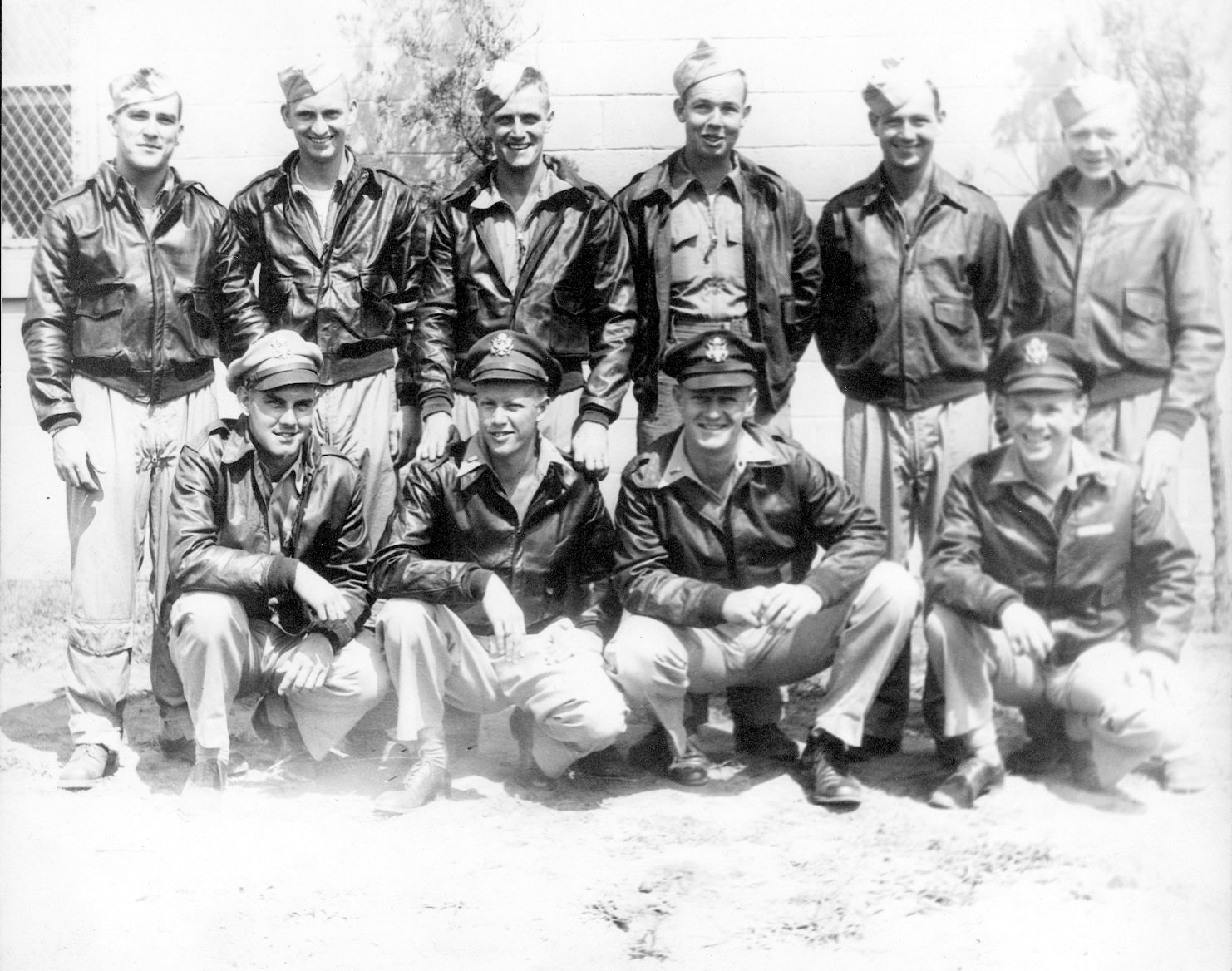
With target disclosure comes an undercurrent of sentiment that sparks a unanimous, yet-unspoken response, “My God, not Merseburg again.” Hardwicke shares this, as well as the expected vocal dissatisfaction, manifested by a series of groans and “oh-no’s.” Early in 1944, the Eighth Air Force embarked on a maximum effort to destroy German petroleum production; deny the enemy oil and his war-making capability will diminish accordingly, it was theorized. German response was predictable: Surround these plants with the most efficient antiaircraft weapons and the most proficient operators; maintain an ever-alert Luftwaffe, despite a dwindling base of experienced pilots.
The paradox of four months past races through Hardwicke’s mind. On July 28, he and his crew began their combat odyssey. Their first mission was to Merseburg and the Leuna complex. They encountered moderate flak, few German fighters, and pathfinder radar was used for bomb aiming from 24,000 feet through solid cloud cover. All returned safely to Framlingham, and Hardwicke recalls an observation by his friend, Red Joyner, after debriefing. “Nothin’ to it, Hugh, I could fly a million of ’em.” Bad news came the next morning at mission briefing by Major Waltz. “OK, fellows, you did a beautiful job on a wheat field yesterday, so today we’ll go back and do it right. No cloud cover, no excuses.”
On this trip, flak near and over the target was “intense and accurate,” and two B-17s from Hardwicke’s low squadron were hit and went down. Flak was followed by FW-190s, and ME-109s and 110s and Hardwicke’s top turret gunner, Avery, claimed a kill. They limped back to Framlingham and once on the ground, counted more than 200 flak and bullet holes in the left wing and tail surfaces. Following debriefing, Red was a bit less optimistic: “I believe they really got mad at us, Hugh, I quit.”
Hardwicke’s Confidence Renewed
Colonel Moller snaps Hardwicke’s momentary lapse. “That’s correct, gentlemen, Merseburg again. This time the mission will, in addition to the 13th, include the 93rd, 4th and 45th combat wings. Overall, we expect to put up around 540 aircraft, of which some 300—including the 390th—will attack the Leuna complex. The 93rd will lead the 3rd Division and Colonel Dolan will be command pilot for our group and wing.” Hardwicke is elated, filled with renewed confidence. Lieutenant Colonel Louis W. (Lucky) Dolan is the 390th’s deputy commander, and he is well known and well respected throughout the Eighth Air Force as one of its most able and experienced combat leaders. He has participated in or led assaults on nearly every major enemy target in Europe. Why, he even looks the part, the handsome prototype of the senior officer. If anyone can take us to and over Merseburg and back home without incident, it just has to be Lucky Dolan, Hardwicke convinces himself. “You’ll be there in about five hours, gentlemen; you know what you have to do, let’s go and do it. Major Waltz will provide the details. Good luck to all of you,” Moller concludes.
“Good morning, let’s make it just the opposite for the Germans,” Waltz begins as mission sheets with A, B, and C Squadron designations are distributed. “As you know, Colonel Dolan is wing lead. He’ll be flying with Captain Gary in 080, A squadron. Major McHenry will lead B squadron with Kenny in 225, and Lieutenant Watts will lead C Squadron with Stene in 013.” Hardwicke scans his mission sheet for the other assignments. He will lead C squadron’s low element, which also includes Goodrich in 337, Norman 807, and Mazzechelli 093; also in C are Tracy 345, Weigand 6143, Sarden 390, Sweeny 026, Coffin 526, Lewis 673, Robison 972, Nash 632. A Squadron shows Dieters in 470, Peterson 407, Jefferson 836, Meigede 7041, Combs 927, Hannold 868, Harris 325, Dognibene 8472, Corcoran 275, O’Conner 375, Booth 519; B consists of Philip 456, Shira 926, Torrance 053, Mitchell 831, Herring 306, Drinkwalter 846, Monit 121, Henry 173, Maddron 274, Kurtz 515, Massa 319, Duppenhaler 967.
“Zero hour is 1300, bombing altitude 26,000, bomb run from 320 degrees magnetic. Combination PFF and visual, 100-foot intervalometer settings, twenty 250-pound GPs.
C-1 autopilot for bomb run.” Waltz is resolute, a pragmatist and what Hardwicke needs at exactly this moment is an extra-large dose of pragmatism. “A squadron start engines at 0740, taxi 0750, takeoff 0805, estimated time of departure 0850, estimated time of return 1625. B squadron start engines 0750, taxi 0800, takeoff 0815, ETD 0855, ETR 1625. C squadron start engines 0800, taxi 0810, takeoff 0825, ETD 0905, ETR 1625. Fighter groups will rendezvous at 1100.”
Mission Checkpoint Locations Not Too Friendly
The pointer the major uses is a slightly shortened pool cue decorated with a red-and-white circular design along the shaft. As he moves from side to side along the platform, alternating between the map and a large blackboard with squadron designations and alignments, his shadow—enhanced by the harsh lighting—dances ghost-like across most of Europe. “Group assembly at 0930 at 9,000. Your mission checkpoints: 5114-0254 at 1100, 5006-0626 at 1155, 5025-1211 at 1030, target 1320; route and checkpoints home: 5028-0936 at 1400, 5007-0744 at 1424, 5044-0455 at 1452, 5117-0301 at 1543, buncher 28 at 1619, base at 1626.” Hardwicke knows the route in all too well and recognizes the checkpoints as close to some very unfriendly German cities.
Intelligence is next. Major Ollie Davis—taciturn, dispassionate—and his staff have been sifting information and transposing the field order into a workable interpretation of today’s mission since midnight. His war room is the sepulcher of secrecy where master target data is stored along with a coded index that translates meaningless numbers into: “Your target is the Leuna complex located just outside Merseburg. The target is a closely built-up area some 4,000 by 1,500 yards with the major axis in a north-northwest, south-southeast direction.” In concert with his description, lights are dimmed and a projection screen lowered just in front of the map. Photos of the plant are flashed on the screen as he continues. “This complex is engaged in the production of fuels and synthetic oils and your approach will be across these railway sidings, which will be on your right. We hope this will minimize length of the bomb run and reduce your exposure to flak. Good luck, gentlemen.”
Lights up, screen up as Captain Robert Lamb takes the platform. His business is weather and he brings with him a vertical cross-section, a layer-cake of clouds and meteorological symbols from ground level to 35,000 feet. “At base,” he explains, “about 5/10s stratus during assembly, winds from 310 degrees at 35. Over the continent, cloud cover is reported to have increased to 7/10s and at the target expect a low haze with reported winds from 320 degrees at 45, thin patches of alto-stratus at 12,000.”
Major Waltz returns for the final reminder. “You know the Merseburg flak, always intense and accurate, not to mention Zeitz. Expect some 1,500 guns in the Zeitz-Leipzig-Merseburg area. You’ll be subjected to tracking and barrage, and be alert to box barrages just before bomb release. We expect minimum response from the Luftwaffe. Any questions? OK, boys, drop ’em sûr le nez.”
“On the Nose, Bombs on the Nose”
“Sûr le nez,” Hardwicke muses. “On the nose, bombs on the nose.” A quaint enjoinder, he thinks, considering all the elements that irrevocably conspire to prevent Sûr le nez. “Ten-shun!” They rise in unison as Colonel Moller and the other staff members depart. “We’re going to Merseburg”; hundreds of B-17s, thousands of men committed to the single most critical phase of any mission, “sûr le nez.” His pipe has cooled, its contents little more than a crust as he carefully taps the bowl against his palm and returns this symbol of calm to his pocket. He, Flickema, and the other crews, among a few muted profanities, begin their short stroll to the dressing shack. This gray, unappealing structure is divided into two main areas, both indisputable reminders of human frailty and mortality. Just within the entrance, crew members deposit personal effects which, in turn, are recorded by Captain George Nelson and placed carefully in small canvas bags, neatly arranged on a series of floor-to-ceiling shelves.
Hardwicke empties his pockets—keys, wallet, and any other item that may aid enemy interrogators should the worst-case scenario materialize. Next he removes his John Marshall High School ring, class of 1939, and his wedding band, inscribed “GOH to HHH Jr. 1942.” He declares all except a prized silver dollar, a gift from his father many years ago. The enemy can glean little from an American silver dollar and its presence on his person is a source of comfort; his good-luck charm has been conspicuously successful. “Thank you, lieutenant and good luck,” Nelson says as Hardwicke and Flickema move to the next room. Here they collect the considerable array of flight clothing and equipment, all designed to protect them from external considerations, man-made and natural. To resist the intense cold of 50 to 60 degrees below zero while five miles above the Continent in an unheated and unpressurized B-17, layers of specially designed clothing are imperative. By now, as he and Flickema gather their gear, the routine is rote. Bulky and uncomfortable, the jacket and trousers are lined with alpaca and wool and fitted with a series of wires and connectors to permit electrical heating. Their boots are made of canvas duck with rubber soles, and electrically heated gloves usually are worn with an inner rayon liner. Flying helmets are leather with a chamois lining and sound-insulated earphone mountings, and designed to accommodate one-piece goggles with either clear or tinted lens. The kapok-filled earphone mountings support the standard headset with adjustable leather-covered headbands. Throat mikes are retained with a brown elastic neck strap.
Oxygen mask, parachute and harness, flak vest made of overlapping steel plates and a steel flak helmet complete the outfit. The customary “Mae West,” that wonderful bright yellow inflatable, is necessary along with the model 1911-A1 .45 semi-automatic both Hardwicke and Flickema carry in their russet-brown leather shoulder holsters.
All Prepared for Contingencies
They are prepared for the known contingencies. Much of the gear they toss in flight bags; they will don it later while awaiting takeoff or approaching enemy territory. Now, joined by Jackson and Papousek, it is time to board the trucks once more, this time for the trip to hardstands that encircle the 6,337-foot main east-west runway and the two 4,400-foot north-south alternate runways. Time, 0705, more than sufficient for the vitally important walk around and preflight checklist. As the truck slows to a stop, Flickema and Jackson pull the tailgate pins and the protective rear cover bangs down. All four toss their flight bags and follow them to the ground.
As the gray light barely sneaks its way across the English countryside, what has been a sprinkling of haze and mist begins to dissipate. What has been merely a cold, impersonal silhouette begins to take shape as the silver surface of a B-17G. Another truck bobs to a stop and the balance of Hardwicke’s crew—Hammond, Weaver, Avery, Downham, and Grogg—all of whom attended separate briefings, disembark. Avery and Downham are wearing most of their cumbersome flying attire while Hammond, Grogg, and Weaver prepare to suit up on the hardstand.
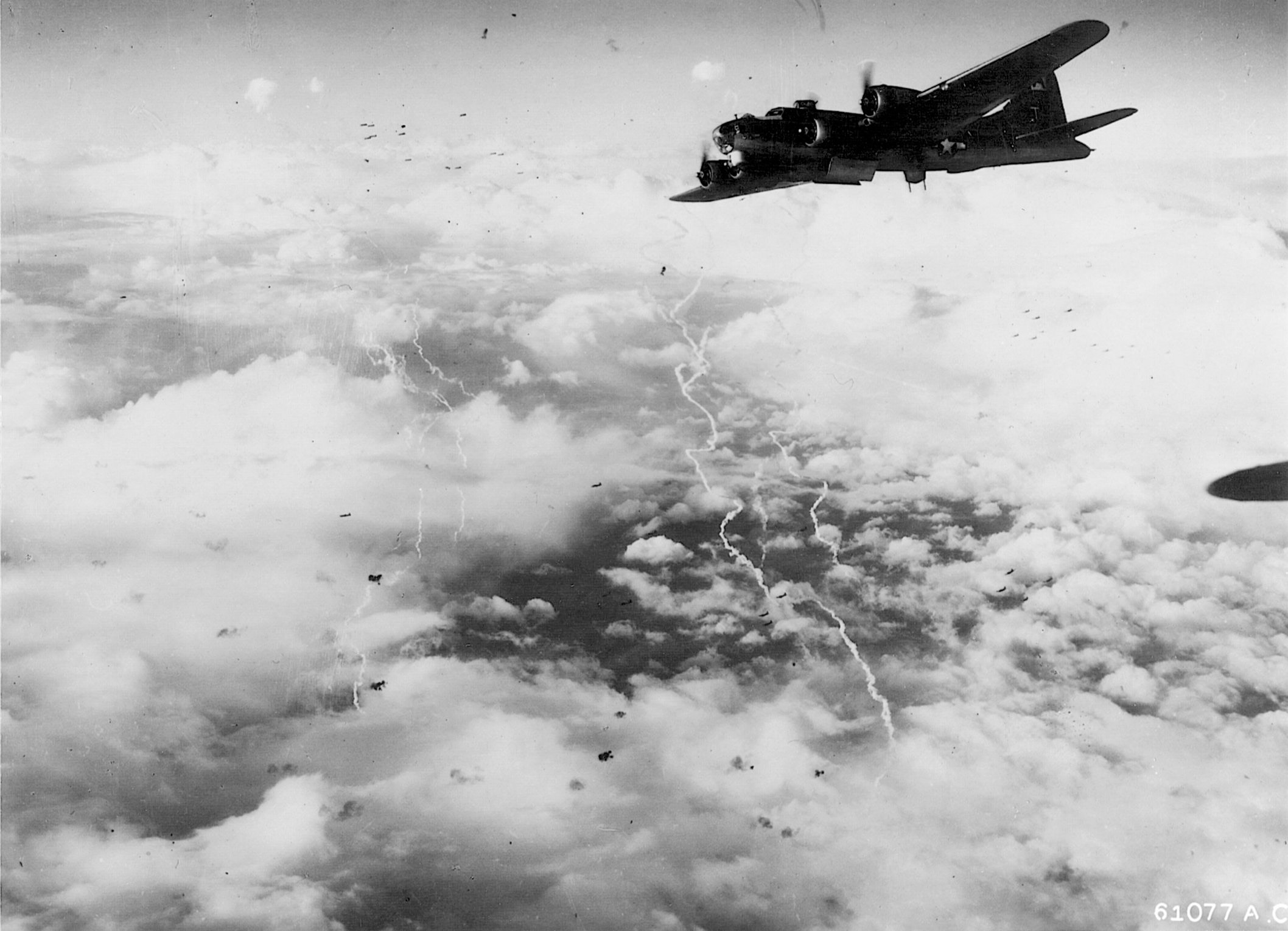
Their transportation to and, with good fortune, from Merseburg is well prepared for the journey. Master Sergeant Blumberg, the crew chief, and his four assistants, have devoted most of the past 96 hours to checking and rechecking all the elements so vital to remaining aloft. Hardwicke had noticed problems encountered during the six-hour mission to Hamm four days previous, including the loss of oil pressure on No. 3 engine on the way home. “No, 3’s OK, sir,” Blumberg reports. “Oil pressure, manifold pressure, prop pitch control all checked and repairs made,” he continues. “How about the left wing aileron control and trim tab alignment?” Hardwicke inquires. “Has been set properly and also pitch control on No. 4 adjusted,” Blumberg responds. “And sir, those hundred or so holes have been patched,” he smiles. Hardwicke grins back, “Good job, sergeant.”
The early-morning light not only discloses surface color, but the more intimate, personal details of this B-17G. Tail number 107176 is found just below the white J within a black square that identifies the 390th as the Square J. The 568th Squadron code—BI—appears in bold, black letters on both sides of the fuselage, almost above the wings and directly in front of the national insignia, a white star on blue background flanked by white rectangular bars outlined in blue; the national identification also is prominent on top of the left wing and bottom of the right. A square J also appears on top of the right wing.
The Bomber Always Safely Returns
Circling the nose, immediately behind the bombardier’s Plexiglas station, is a 14-inch red band which further identifies the 568th, and below the navigator’s windows and rows of vertical bombs, her names: “Uninvited” and “Missionaires.” Two previous crews have named her, and in the best tradition of good luck, Hardwicke and his crew accepted both. They did, however, select “Uninvited” for the backs of their A-2s, along with ever-increasing strings of yellow bombs. No. 176 is solid, reliable, and has carried them through 14 of their 25 combat missions. No matter the battle damage, thanks to her resilient character and their precise flying skills, always a safe return to Framlingham.
“OK, Flick, Sergeant Blumberg, let’s look around,” Hardwicke says. The essential visual inspection begins with the right wing. “Aileron, flaps, de-icer boots OK, no fuel leaks, air ducts clear, props look good,” Flickema notes. They check No. 3 and No. 4 engines; cowl flaps secure, exhaust systems OK, turbo wheels smooth. Next comes the main wheel; tire OK, hydraulic lines, drag link, and strut OK. Around the nose, pitot-tube covers removed, antennae leads connected, trailing antennae retracted, marker beacon secure. Engines No. 1 and 2 OK, left landing gear OK, aileron surfaces and trim tab alignments OK on the left wing, external locks removed. Tail guns in position and locked, gunner’s escape door closed, tail wheel inflated properly, shear pin and slot not rounded or worn. “She looks just fine, Hugh,” Flickema observes, “let’s get aboard.”
Taking Their Places on Board
Most of the crew enters through a rear door, but for those with positions on the flight deck and in the nose, “getting aboard” means by way of an emergency hatch aft of the navigator’s station. Described as a “cupid’s leap,” the process requires grasping the upper, outer edge of the opening with both hands, lifting and swinging both legs through while twisting them down the fuselage in the process. With a final heave and squirm, one’s body is deposited with somewhat of a thud.
Hardwicke and Flickema take the leap first, followed by Jackson and Papousek. A turn and step up and pilot and copilot are ready to occupy their accustomed bucket seats of aluminum construction with padded backs and cushions clearly marked “Do not remove from airplane.”
They stow their parachutes and flight bags and slide into place, Hugh on the left, behind individual control columns. These are shaped like half-wheels with three spokes connected to a centerpiece properly identified, “B-17 Flying Fortress” above the Boeing Company’s signature, a vertical B-o-e-i-n-g attached at the O with a pair of stylized wings.
They are surrounded by a maze of instruments, switches, dials, and knobs—to the front, above, and on both sides. The cockpit is far from spacious, but thanks to a design engineer who recognized the need for excellent visibility as well as the psychological value of light, they also are surrounded by windows—to the front, above, and on both sides. As Hardwicke adjusts his feet to the rudder pedals and settles into the position he will occupy for the next seven-plus hours, his thoughts drift for a moment.
Hardwicke In His “Office”
Behind the controls he is at home. Although it may be a bland metaphor, the cockpit is his office, a place where he functions best. With some 500 B-17 flying hours and countless more of ground instruction, he glances around with an inner satisfaction. He has not just learned, he has absorbed the instrumentation. Yes, he can, even when blindfolded, identify and render each device properly.
The console between pilot and copilot holds the tools through which they will gain and sustain flight. The B-17, unlike any other four-engine aircraft in service, incorporates a set of three throttle controls. Grasp the top rung and engines 1 and 4 will respond, while the bottom rung activates engines 2 and 3; the split middle rung, the one most used, offers all four simultaneously.
Throttles and their base feature a distinctive metallic green color and the adjacent throttle control lock is topped with a white knob. Controls forward of the throttles include fuel mixture and turbo-supercharger, ignition, fuel-boost pump, fuel shutoff, wing flap, landing gear, and light switches. A lower pedestal features the elevator and rudder trim tab wheels, elevator and rudder lock, autopilot flight control panel, and tailwheel lock.
Above the windshield one finds a clock, compass, and de-icer pressure gauge; above and between Hardwicke and Flickema resides their prime radio equipment, command receiver unit, loop, light and volume switches, band selector knob, tuning crank, transmitting key, and channel selector. At Hardwicke’s left, controls range from the windshield de-icer to the aileron trim tab control; to his front, a series of instruments: pilot’s directional indicator; emergency bomb salvo button; radio compass; oxygen flow indicator, altimeter, and indicators for airspeed, rate of climb, turn and bank plus directional gyro and prop-feathering buttons.
To Flickema’s right are found, among others, intercooler controls, engine primer hydraulic hand pump, engine-starting switches, carburetor air filter switch, parking brake, and engine fire-extinguisher controls. And in front, set against a dark panel, pressure gauges of vital consequence: manifold, fuel, oil, along with temperature gauges for oil, carburetor air, free air, and cylinder head; also tachometers, fuel-quantity gauges, and flap-position indicator.
Putting Abilities to the Test for Dreaded Merseburg
Hardwicke knows that today his ability will be tested yet again, to Merseburg, dreaded Merseburg. Yet, Lucky Dolan is going to lead, and after all, there are two sevens in the tail number, and early on they had been designated as “replacement crew No. 7.” Just for good measure, he finds in his A-2 pocket a certain silver dollar and permits it to slide gently between his right thumb, index, and middle fingers. No. 176, “Uninvited,” may be owned by the Army Air Forces, but she belongs to Hardwicke and his crew, a proprietary interest that began on September 2, when she was assigned as their aircraft. They had logged almost 190 combat flying hours since July, of which a little more than half have been in “Uninvited.”
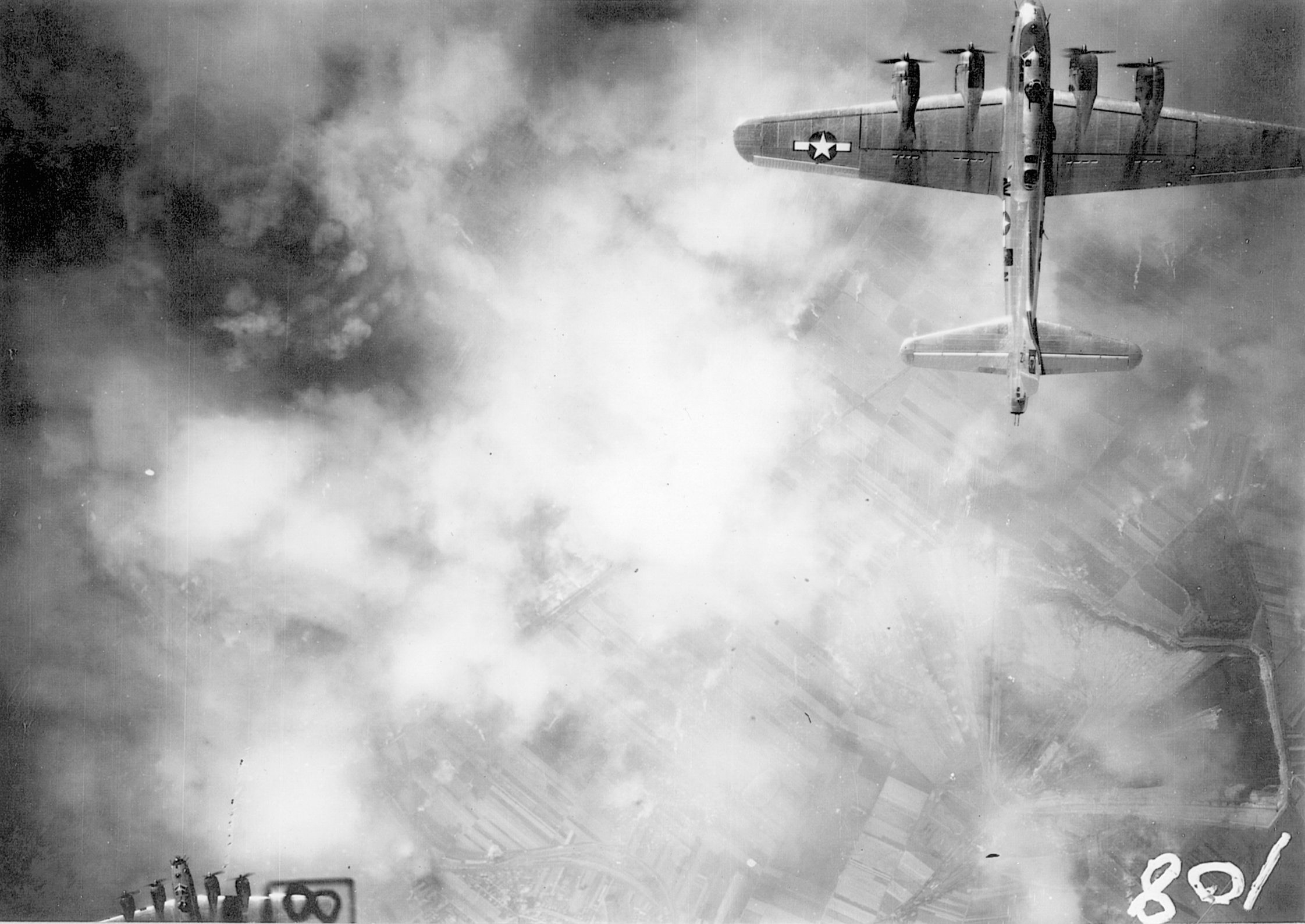
Hardwicke adjusts his headset over his flying helmet and goggles, firmly in place over the left ear but set behind the right to better hear Flickema, plugs into the command frequency, and snaps in place his throat mike when word from the tower is received. Prepare for at least a half-hour delay to permit more favorable weather in the target area. C Squadron engine start now 0830, taxi 0845, takeoff 0900, ETD 0945. Flickema nods to Hardwicke in confirmation.
“Damn,” Hardwicke mutters to no one in particular. Delays always are tedious and sometimes weather closed on the field, as was happening now, or over the target, and in some instances this led to a mission scrub. He checks his watch, 0750. Enough time, he thinks, for an interior inspection; something he did rarely because of complete confidence in his crew. But today, everything must be in place, all in readiness. He eases from his seat, “Going to take a look inside, Flick.”
A check in the nose discloses a somewhat relaxed Papousek and Jackson engaged in casual conversation. “Everything OK?” he inquires. “Current maps, radio facility charts, navigational aids, direction-finding charts?” “Sure, Hugh, all right here,” Jackson responds. As he looks around, portable oxygen bottles in place, ammo stored properly, first-aid packets OK, nose guns secure, bombsight ready. He turns with the traditional OK sign, thumb and index finger locked in an oval, and they return the gesture.
From nose to the top turret; switches in off position, oxygen bottles stored correctly along with fire extinguishers. He navigates the tricky narrow catwalk between bomb racks. This is Papousek’s domain and he is methodical; bombs are OK, bomb bay doors closed, no excessive gasoline fumes, hand transfer pump in place.
Preparing for Flight
He moves to the radio compartment. “What’s up, Hugh?” Weaver asks. “Just checking.” Extra parachute stored, main oxygen system OK, emergency landing gear hand crank in place and locked, life raft emergency release handles set properly. On to the waist. Ball turret and waist guns secure along with ammo, windows closed, control cables clear. In the tail, drag link screw and assembly in alignment, control cables OK, section neat. He returns to the flight deck satisfied, reassured.
“Everything OK, Hugh?” “Looks good, Flick, didn’t think it would be otherwise. I just need to be sure,” Hardwicke says as he resumes his position. It is 0805, time for the preflight check. This pilot-copilot ritual, no matter how often orchestrated, is serious and never taken for granted. Flickema has the list in hand and begins in a loud, clear tone with either he or Hardwicke responding. “Pilot’s preflight complete, form 1A checked; controls and seats, checked; fuel transfer valves and switch off; intercoolers cold; gyros uncaged; fuel shutoff switches open; gear switch neutral; cowl flaps open right, open left, and locked; turbos off, idle cutoff OK, throttles closed, autopilot off, de-icers and anti-icers wing and props off, cabin heat off, generators off.”
Rudder, elevators, and ailerons are put through the full range of movement and proper direction of operation. Hardwicke and Flickema adjust their seats and safety belts to ensure freedom of movement. It is 0831, green light from tower, time to start engines. Hardwicke goes on the intercom, “All positions check in.” “Tail to pilot OK, waist to pilot OK, radio to pilot OK, ball to pilot OK, top gunner OK, navigator and bombardier OK.”
Hardwicke and Flickema slide back their side windows and call to the ground crew, “Fire guard clear.” Flickema continues the checklist. “Master switch on, battery switches and inverters on and checked, parking brakes on, hydraulic check OK, carburetor filters open, booster pumps pressure on and checked.” Avery, standing behind the pilots, monitors the process carefully, especially engine instruments and controls.
Ready To Start the Engines: B and C Squadrons On Their Way
The engine-starting sequence is left to right, 1 to 4. Hardwicke makes sure both engines on his side have the props pulled through three or four complete revolutions, and Flickema does the same. Hardwicke holds up an index finger, and Flickema responds, “Ready to start No. 1.” Flickema energizes and expels air from the primer until he has a solid fuel charge. Some 12 seconds later Hardwicke calls, “mesh No. 1” and Flickema, while still holding the switch at start, moves the mesh switch to the correct position and continues to prime until the engine fires with a rush of blue exhaust. Hardwicke sets the mixture to autorich and notes the oil pressure is coming up.
The process is repeated three more times, and now all engines are running smoothly. Flickema returns to the checklist, “Flight indicator and vacuum pressures checked.” He keeps close watch on engine instruments and calls to Hardwicke, “Oil temperature 70 degrees, oil pressure 75 pounds, clock set, magnetic compass float level, flap position checked and ready.”
The green light flashes from the tower, and it is time to taxi. Hardwicke and Flickema order wheel chocks removed by the ground crew, still alert with fire extinguishers in hand. The engines are performing well, and Hardwicke knows the drill. Keep the inboard engines idling at not less than 500 rpm with just enough friction lock applied to prevent the throttles from creeping. Using throttles, with as little brakes as possible, Hardwicke rolls No. 176 slowly onto the taxiway that surrounds the main and auxiliary runways. As “Uninvited” settles into the engine din and associated vibration, Hardwicke joins the almost apparitional procession: B-17s in front, behind and, it seems, on all sides.
By now, A squadron has departed and B is well on the way. C Squadron, at 45-second intervals, is next. No. 176 reaches the engine run-up area, and Hardwicke and Flickema begin final checks. “Brakes set,” Flickema confirms. Hardwicke runs up each engine and checks magnetos, rpm, and voltage output as Flickema checks fuel and oil pressure, as well as cylinder-head temperature. The run-up is complete, engines OK.
Hardwicke steers “Uninvited” into takeoff position on the main runway as he and Flickema watch the preceding B-17 clear a patch of woods at the far end and disappear into the mist that has begun to shroud Station 153. Forty-five-second intervals are just enough to avoid propwash, which, if flown into, may stimulate undesirable aerodynamic characteristics.
Takeoff, the Most Critical Moment
“Cowl flaps open, trim tabs set, gyros set, tailwheel locked, autopilot off, brakes set,” Hardwicke and Flickema agree. No. 176 is held stationary as Hardwicke, with the conventional palm-up grasp, advances the throttles to full takeoff power. Engines thunder, the plane shivers as brakes are released and it begins, not a rush to altitude, but a swaddle—in Hardwicke’s view, a sort of proud half swagger, half undignified waddle. Some 65,000 pounds of airplane, fuel, bombs, and crew lurch forward.
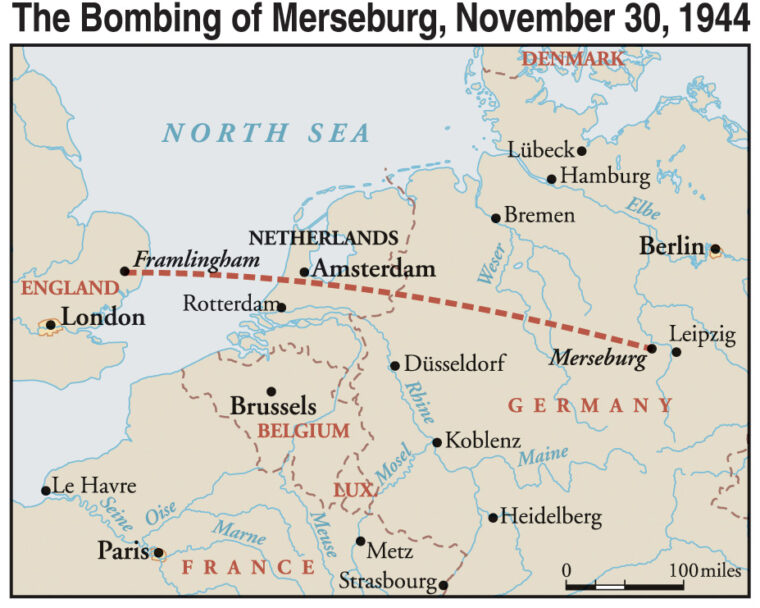
Takeoff is the most critical moment, and one mistake means “Uninvited” becomes their final resting place. The fuel mixture is full rich, and the airplane is in a straight line on the runway as Flickema begins the all-important airspeed calls. He intones, “60, 70,” and with very little pressure on the control column the tail rises; “80” and the yoke feels light as speed increases, “90, 100, 110” as the end of the runway rushes toward them, “115, 120” and Hardwicke feels air under No. 176. The plane is past stalling speed, committed to flight. “Uninvited” is airborne, and Hardwicke eases back on the control column. Throttles remain full, mixture full rich, 2,500 rpm as “Uninvited” slices through the fog.
Once airborne, Hardwicke calls to Flickema, “Wheels up, cowl flaps closed.” Flickema applies brakes slowly to stop rotation on the wheels as they slide gently into wells beneath engines 2 and 3. Both make a visual check. “Gear up left, gear up right.” Flickema closes the cowl flaps and retracts the tailwheel. All is well; manifold pressure, oil pressure and temperature, rpm, airspeed at desired levels. Now begins the tedious climb to altitude and assembly.
They follow a VHF “buncher” beacon, a radio signal designed to guide planes into their proper areas for formation assembly. The crew is on high alert for other aircraft as they rise at 200 feet a minute without visual reference. Their only identification signals are blue running lights on the wingtips, and mid-air collision is a very real possibility. Some groups climb faster, some slower, and an incident of a month or so ago flashes before Hardwicke. Suddenly, a B-17 with a black triangle, not a square J on its tail, popped from the clouds and rushed past them much too close for comfort.
Up to 7,000 Feet
It is a busy time in the cockpit. Flickema adjusts fuel mixture; he and Avery monitor manifold and oil pressure as they continue to climb in a giant counterclockwise circle. In theory, all 390th aircraft are laboring through the same process.
At 7,000 feet, they shake free of the murk and suddenly face the glorious evanescent hues of sunrise. During those few transitory moments, Hardwicke lowers his tinted goggles to help shield glare reflecting off the left wing. It is magnificent, exhilarating; streams of light from above, generous banks of white clouds below, and Hardwicke’s faith is reinforced. Only God, he assures himself, is capable of such beauty. For the first time since takeoff, other aircraft are clearly visible, their silver forms well defined.
Hardwicke and Flickema guide No. 176 into its position as C Squadron low-element lead. Throughout this process, and the mission, they will alternate flying “Uninvited” for 20- to 30-minute intervals. Gradually, inexorably, the group takes shape as other ships find and fit into their assigned slots. Jackson becomes the most important crew member; his responsibility is to be absolutely certain of their exact location at all times. Others are occupied with checking planes around them. Assembly is nearly complete, and once more Hardwicke marvels at the accomplishment as the 13th Combat Wing, above, below, ahead, and behind, readies itself for the journey to Merseburg.
The bomber stream is designed with time and space intervals allocated to the many groups. There are maybe a hundred feet between Hardwicke and the squadron elements ahead with 500-foot vertical squadron differentials, necessary separations to avoid propwash and ensure an envelope of reasonably stable air. Today, assembly has required about an hour as they continue to climb, and Hardwicke knows the departure point, Southwold on the North Sea coast will be reached momentarily.
“Departing English Coast Three Minutes Early”
“Navigator to pilot, departing English coast three minutes early.” Hardwicke responds and checks the clock, 0942. A few minutes later, at 10,000 feet, he alerts the crew to “go on oxygen.” Each acknowledges and snaps his A-14 rubber mask in place where it will remain for at least the next six hours. Although manufactured with consideration for facial contours, it has become its own oxymoron, a vital irritant. Hardwicke knows this heading will carry them across the North Sea, over Belgium and the battle line, and into Germany. It is not exactly an easy route with enemy fighters and flak batteries on alert to greet them.
Defense against fighters is characterized as a gleaming three-dimensional sword, its edges tempered by skill and experience. The marksmanship of No. 176 gunners Avery, Grogg, Downham, and Hammond is superior, not to mention Papousek, responsible for the electrically driven chin turret and sharing the two cheek .50s in the nose with Jackson. They represent the initial edge.
Edge two is the carefully developed staggered, three-plane elements within a squadron and staggered squadrons within a group. They are positioned to provide a compact yet easily maneuverable “box.” This permits maximum, concentrated firepower, sustained by consistently tight formations.
Edge three is the fighter escort of “Little Friends.” Today, the fighters will be North American P-51D Mustangs, which will rendezvous near the battle line. The fighter pilots, displaying superior combat aptitude in a single-engine aircraft whose range and versatility is unparalleled in European skies, have achieved impressive scores against the Luftwaffe.
Hardwick’s Defense: Prayer
Hardwicke has considered ways to defend against flak on a number of occasions during their previous 25 combat missions. He has produced but one answer—prayer, sometimes silent, often articulated with vigor. But he has more important considerations just now. “Pilot to gunners, check ’em.” “Roger,” each responds. As weapons are activated, spent shell casings ricochet throughout each position, muzzle flashes are clearly visible, the odor of cordite noticeable. Each time firing begins, in test or combat, Hardwicke thinks to himself, “Damn well hope old 176 can take the stress one more time and not come unglued.”
As they continue to climb, fuel conservation is essential, and Hardwicke knows the technique of adjusting a leaner fuel-air mix, as long as cylinder-head temperatures remain at acceptable levels, for just such a purpose. In addition to concentration and composure, combat flying requires enormous stamina; physically demanding, it is work for the young. As low-element leader, he must maintain position as smoothly and evenly as possible to ease the flying burden on his two wingmen, as well as the poor soul flying below and behind him in “Purple Heart” corner.
“Navigator to pilot, just crossed the enemy coast, four minutes early.” “Roger, Jack.” At 15,000 feet, Hardwicke calls for an oxygen and equipment check and exhorts the crewmen to ready their flak helmets and vests. At high altitude, life expectancy without oxygen declines sharply; with temperatures hovering between 50 and 60 degrees below zero, any malfunction in the heated suits, gloves, or boots may be catastrophic to one’s extremities. From tail to nose, they acknowledge the check call in the affirmative. Flickema points to his mask and nods as does Hardwicke, and both certify their suits are plugged securely to the heater outlets.
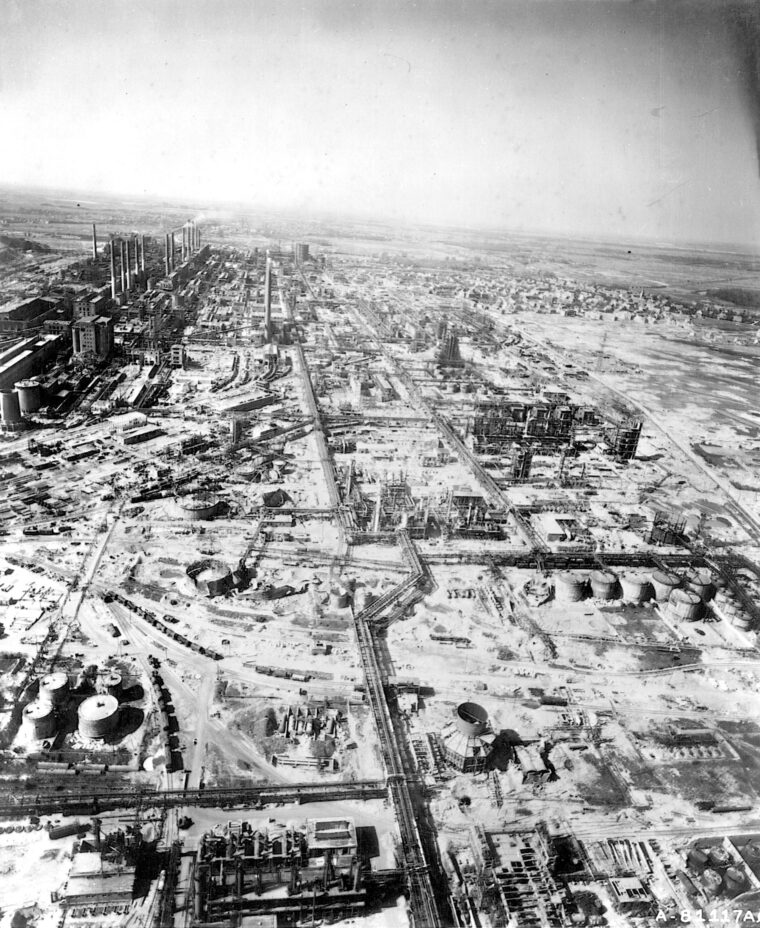
“Why So Much Essing?”
Once again, Jackson alerts Hardwicke, “We’re climbing too slowly,” and asks, “Why so much essing?” “Pilot to navigator, think the 93rd was late making altitude, had to wait for them.” Hardwicke knows that sustained essing, slow turns, and leveling off every 5,000 feet, eventually will permit the 93rd to take its position as lead wing; he also knows that the practice may stimulate course deviations and interfere with time to target.
When they cross the battle line there is heightened alert, and the vigil for fighters and flak intensifies. Flickema monitors the escort radio channel and once again chuckles to himself that “Little Friends” are, indeed, quite verbose. At the same time, radio contact within the group and wing is forbidden except in an emergency.
“Bombardier to pilot, ready to arm.” “Roger, Chick, go.” Papousek collects a portable oxygen bottle, connects his mask and, from the nose, moves past the flight deck, under the top turret, and swings open a door leading to the bomb bay. The catwalk is flanked on either side by bomb racks holding the 20 250-pounders. Papousek braces himself against the sometimes violent and always unpredictable aircraft movement, and carefully places his oxygen bottle in a nearby rack. Now he begins to remove the wires that secure a small propeller on the nose of each bomb. As the finned explosives are disgorged, the propellers twist and, at set intervals, activate the bombs to explode on impact. Papousek completes his work quickly and will add these wires to his already impressive collection, labeled with the date and destination of the 25 previous missions.
Cruising at 25,000 feet develops a shimmering contrast. The azure blue above forms a stark backdrop for the brilliant-white contrails below, as moisture from superheated engine exhausts freezes into vapor trails that extrude for miles behind each B-17. Hardwicke often ponders how awesome and how terrifying the sight must appear for those on the ground, especially those in close proximity to the target. While contrails may accentuate fear on the ground, in the air they provide excellent cover for German fighters sneaking through to pounce at very close range.
No Enemy Fighters Yet?
Enemy fighters have not yet been sighted by the 13th Combat Wing or its Little Friends. Maybe, just maybe, Hardwicke contemplates, Major Waltz was correct in the assessment to expect “minimum response from the Luftwaffe.” What a constructive thought, that German fighter strength had waned to the brink of ineffectiveness. Yet, in a vivid flashback, he recalls their second journey to Merseburg.
“Tail to pilot, they’re comin’ through the contrails, Jesus, must be 10 or 15, look like 190s and 109s.” Pappy Grogg greeted the intruders with short bursts. “Top to pilot, I see the bastards,” and as they peeled to the left, Waymon Avery followed with his contribution. Later, group intelligence reported that the 390th had been attacked by 12 Focke Wulf Fw-190s, five Messerschmitt Me-109s, and four Messerschmitt Me-110s. Avery claimed a 190, but had to share credit with the top turret gunner of their wingman. German flak was even more productive, sending two B-17s from Hardwicke’s low squadron to earth in flames.
Hhat was late July. Now in late November, “Navigator to pilot, CP 3 at 1155; we’ve been losing time and our heading has changed. We’re 15 to 20 miles south of the briefed course. If we stay on this heading, we’re going to miss the IP.” “Pilot to navigator, can’t help it Jack, we’ve got to follow the 93rd. Too damn much essing.”
“Bombardier to Pilot, Flak Comin’ Up”
Although German fighters mercifully remain absent, the second deadly F, flak, is expected any moment. Hardwicke and crew have become experts: 88s generate a sharp crack and black puff; 105s and 155s, muffled booms and gray puffs. Sometimes ground flashes may be spotted from the nose and both Papousek and Jackson keep Hardwicke informed.
“Bombardier to pilot, flak comin’ up.” Crack, crack, black puffs off the left wing; more cracks, more puffs, so far ineffective. A flash, crack, puff sequence comes once more, this time much too close, and with it comes the inevitable concussion as shrapnel hits “Uninvited.” Hardwicke knows shrapnel, from pen cap to softball size, is deadly unto itself; he hopes for more pen caps. “Pilot to crew, check for damage.” Their responses are negative.
Once more, Hardwicke and Flickema check instruments. Indicated airspeed 150, manifold pressure 29 inches, fuel mixture autolean, booster pumps on, props in synch, superchargers OK, rpm 2,000, carburetor air temperature 21 degrees centigrade, cylinder-head temperature 210 degrees centigrade, ship properly trimmed. With flak, each pilot reflexively seeks more space, room to perhaps escape those bursting projectiles. Hardwicke watches aircraft on either wing closely; ahead, he sees Tracy and Weigand drifting too close. They correct in time. His low element maintains its integrity.
When the 13th Combat Wing begins its bomb run to target, Jackson once again alerts Hardwicke—“We’re turning a helluva way past the briefed IP; I’d say we’re about 25 miles too far south and 12 minutes behind schedule. Hugh, this heading will take us over Zeitz and we’ll have to fly the bomb run on an elongated approach.” The briefed bomb run was designed for them to cross the target at its narrowest point and avoid as much flak as possible. Now, they will be exposed to the maximum wrath from enemy gunners at both Zeitz and Merseburg. To exacerbate their dilemma, a cruel headwind retards bomb-run speed and offers these gunners even more time to refine range and accuracy.
The Pounding Starts, Popping Much Too Close
Above Zeitz the pounding begins in earnest. Crack, crack, crack, boom, boom, boom, black puffs, gray puffs, flashes, and more flashes. It is popping close, much too close. Some flak fragments slice through the fuselage, wings, and tail, so far without significant damage to ship or crew. Tracking flak, barrage flak, pointed flak—they are, indeed, recipients of the most advanced German technology and the gunners’ tenacity to inflict maximum losses on the airborne invaders.
Hardwicke holds formation, occupied with throttles, rudder control, trim and aileron adjustments; Flickema is alert for flak and fighters. “Navigator to pilot, gonna be a damn long bomb run, maybe seven or eight minutes too long.” They are surrounded by dense, black walls of violent bursts, and in the midst of this most vicious assault from the ground, Hardwicke has no time for fear, but there is a thought. “Please God, get us through this, would appreciate a third wedding anniversary and a 24th birthday.”
Flak batters and buffets No. 176, as yet without major harm. “Pilot to bombardier, since we missed the IP, Chick, more essing necessary. A Squadron’s too close, gotta avoid ’em. Can’t drop ’till they’re clear.” Papousek acknowledges, and three minutes later, “Pilot to bombardier, we’re OK now, we’re clear.” Papousek recognizes it is neither feasible nor possible to drop on the leader as is always the bombing plan. “Bombardier to pilot, bomb doors open, target obscured by haze and smoke.” Within the next minute comes a two-word message always received with enthusiasm by combat aircrews; the succinct summation of their mission: “Bombs away!”
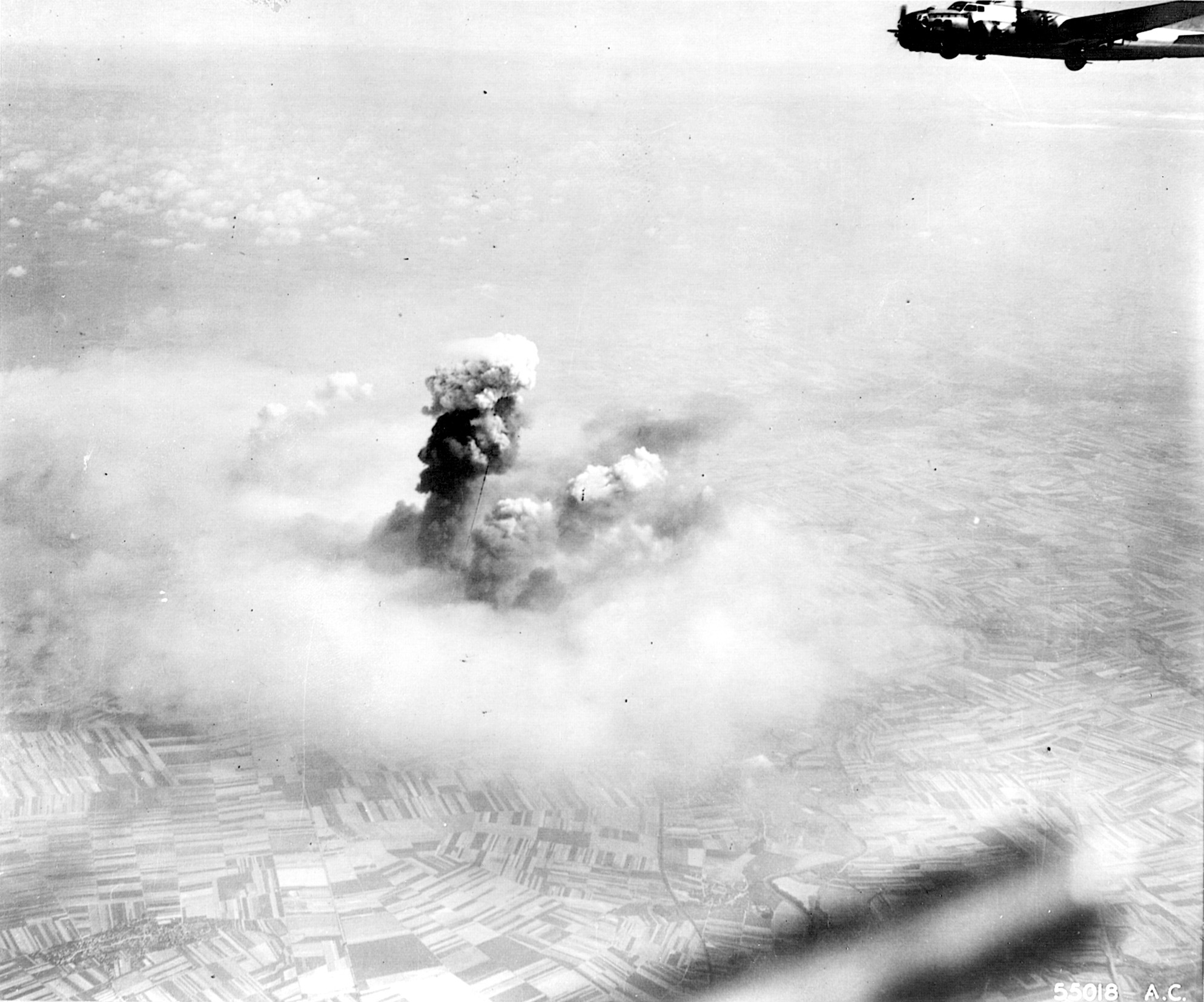
B-17 No. 176, some 5,000 pounds lighter, rises, and Hardwicke, as he has done on 25 previous occasions, compensates. Then, from Weaver, who has an unobstructed view of the bomb bay from his radio room, “Radio to pilot, one hanging, your end of rack.” Hardwicke activates the emergency bomb release, without results. “Pilot to bombardier, still hanging.”
“Bombardier to Pilot, It’s Salvoed”
“Bombardier to pilot, on my way.” Once again, Papousek makes the trek from nose to bomb bay, only this time, with open bomb doors, he must overcome wind force and extreme cold as well as steady himself against the unpredictable aircraft pitch and roll. He spots the problem quickly, and with a slight adjustment to the rack the missile drops free. “Bombardier to pilot, it’s salvoed.”
“Pilot to bombardier, thanks Chick.” Jackson closes the bomb doors and alerts Hardwicke.
With unanticipated suddenness and ferocity, the carnage intensifies. Hardwicke concentrates on formation integrity, ever aware of the B-17s on either wing and those ahead. Then, the unthinkable happens. It seems to him one massive, sweeping, flak burst strikes just about every plane in A Squadron. As if in slow motion, the lead ship, flown by his friend Dana Gary with Lucky Dolan aboard, inexplicably rises, wings over, and settles upside down on top of his wingman. When they touch, both are obliterated. From the fireball emerges an engine, its prop still spinning, and very small fragments of wing. Hardwicke watches as they fall and exclaims to himself in disbelief, “My God, the bastards got Dolan, they got Dolan.”
It was inconceivable, impossible, not Lucky Dolan, the one man who could lead them safely to and over Merseburg and then home. Almost simultaneously, another A Squadron ship disintegrates from a direct hit, then another, and yet another. Trails of fire, debris, dead B-17s, dead crewmen litter the sky. No. 176’s intercom comes alive: “Those poor bastards … how many … who … happened so damn fast … see any chutes … no … none … not one.” In a voice steeled by the mixture of adrenaline and inner strength, Hardwicke cuts through the horror. “Pilot to crew, long way to go boys, stay alert, check for flak hits.” Inside, his thoughts are less comforting. “Will any of us survive? Will any of us make it home?” As the gruesome panorama of men trying to annihilate one another swirls around him, Hardwicke relies on a practiced calm and analytical detachment to sustain sanity and control.
The Relentless Barrage Continues
In what may have been 60 or so seconds of sustained fury, A Squadron is decimated and in disarray, B Squadron’s leader and two more are missing. Only C Squadron, miraculously, remains untouched by fatal flak hits. The barrage continues. It is relentless and unyielding, and “Uninvited” shudders. A sharp burst under the left wing, and No. 2 engine begins to vibrate and belches a wisp of blue smoke. Calmly and clearly, “Pilot to crew, looks as if we’ve taken a hit in No. 2 engine, will keep you posted.” While there may be a tinge of apprehension, all respond with a tone of confidence, unshakable in the belief that Hardwicke will resolve the situation in their favor.
Hardwicke and Flickema use the knowledge only many hours of arduous combat flying can provide. Oil and manifold pressure for No. 2 begins to drop, and Hardwicke sees ripples of black liquid seep from under the cowl flap and blow back across the wing surface. So far, no fire, but he knows that No. 2 must be feathered before all oil is lost. The decision made, they begin the all-too-familiar procedure: throttle back, feathering button pressed, mixture and fuel booster off, generator off, turbo off, prop low rpm, ignition off, fuel valve off. Hardwicke watches the prop slowly wind down and stop; he signals thumbs up to Flickema. More work is required as Flickema adjusts mixture controls for the other three engines.
They emerge from what seems an interminable vortex of destruction as the only 390th squadron without loss of aircraft. The remnants of A and B squadrons form on C, which has taken the lead, as they pass the rally point and prepare for the return flight to Framlingham. “Pilot to crew, how many do you count?” Five or so minutes elapse before consensus. “21, counting us, 22.” It does not require a nimble mathematical mind to quickly compute that of 37 ships on the bomb run 14 with around 125 crewmen aboard are, for the moment, missing. Hardwicke knows that some may have joined other groups, some may have crash-landed, and some may land safely. Verifiable losses will not be established until tomorrow.
“Tomorrow,” and Hardwicke realizes he is thinking demonstrably in the future tense. Less than an hour earlier, tomorrow was an ambiguous, even obscure concept. For the first time since takeoff, he allows himself to relax just a little and signals Flickema to take the controls. Hardwicke removes his flak helmet, lifts his goggles, squints a few seconds, adjusts his oxygen mask, and then wipes the sweat from his forehead and face. As he stretches within the cramped area between seat and controls, “Navigator to pilot, heading 270 degrees, altitude 24,500, ETA 1700.”
“We’ll Be Home … in Time for Supper”
“Roger Jack. Pilot to crew, another three hours and we’ll be home … in time for supper.”
Despite the loss of No. 2 engine, an instrument and control surface check discloses all is well. Further examination of No. 176 by other crew members indicates no additional flak damage of consequence. They follow the 490th group in a gradual descent, one that will carry them over two more checkpoints, the battle line, North Sea, to buncher 28 at Framlingham. The sunset they chase is brilliant for late November, and as far as Hardwicke can see, a harmonious, even synchronous coalescence of silver shapes with but one destination—England.
They … No, it’s more personal … He has defeated Merseburg. He, his crew, “Uninvited,” have not just endured, they have prevailed. Their 26th mission is nearing completion, and in this knowledge comes a renewed vitality, a resolute confidence that the next nine will be flown without mishap. Yet, today’s price for the 390th alone is significant: Lucky Dolan, Dana Gary and his crew, those aboard 407, Gary’s wingman, and the others who vanished so quickly. In combat an invisible line defines who will live and who will not. Hardwicke now knows, thanks to divine influence, with manifest certainty he will not cross that line.
A Happy Letter To Write to the Wife
In almost daily letters to Gladys, Hardwicke has, with unshakable faith, assured her that, no matter what she may hear, he will return to her as soon as the war is over. Survival today over Merseburg has vindicated his optimism. Tonight when he writes, he will employ their code for a successful mission with an understated amendment: “Dearest Gladys, we worked extra hard today.” It is an inadequate tribute to his friends and the others who died, but the censor will not permit expansive personal observations.
With these thoughts, fatigue yields to a compelling inner strength. Hardwicke adjusts his goggles and oxygen mask, taps Flickema on the shoulder, points to the control column. “I’ll take her, Flick.”
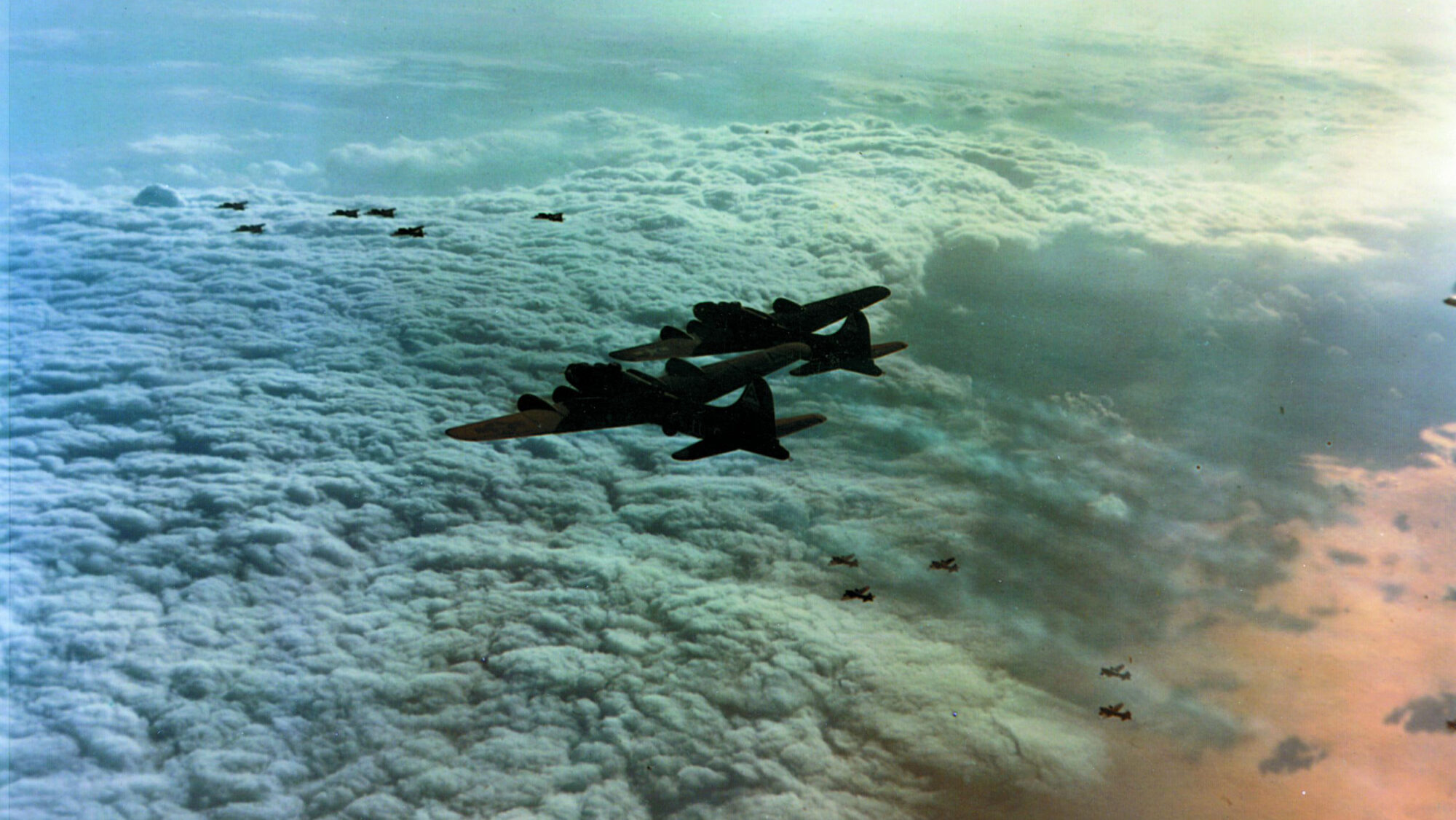

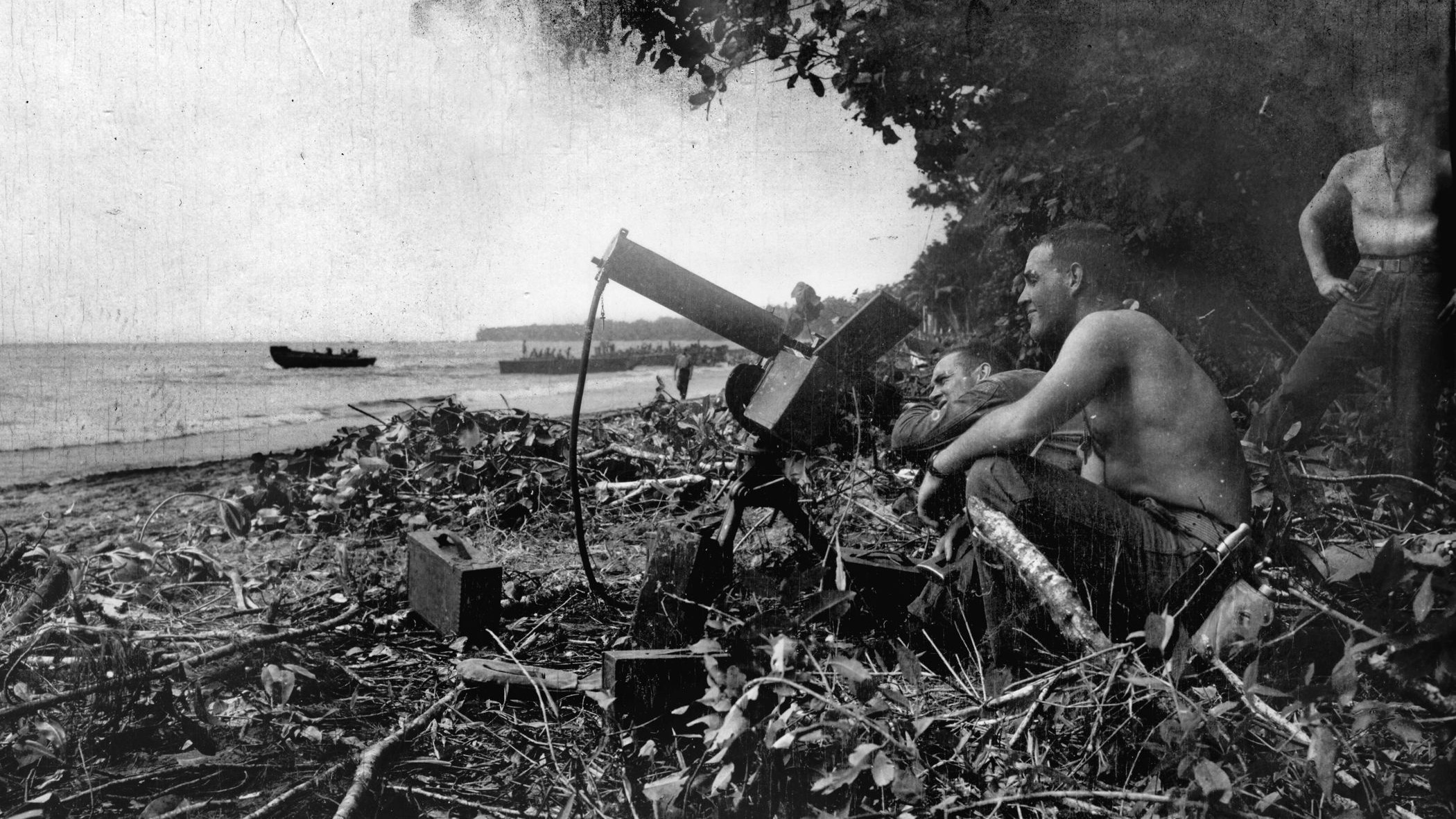
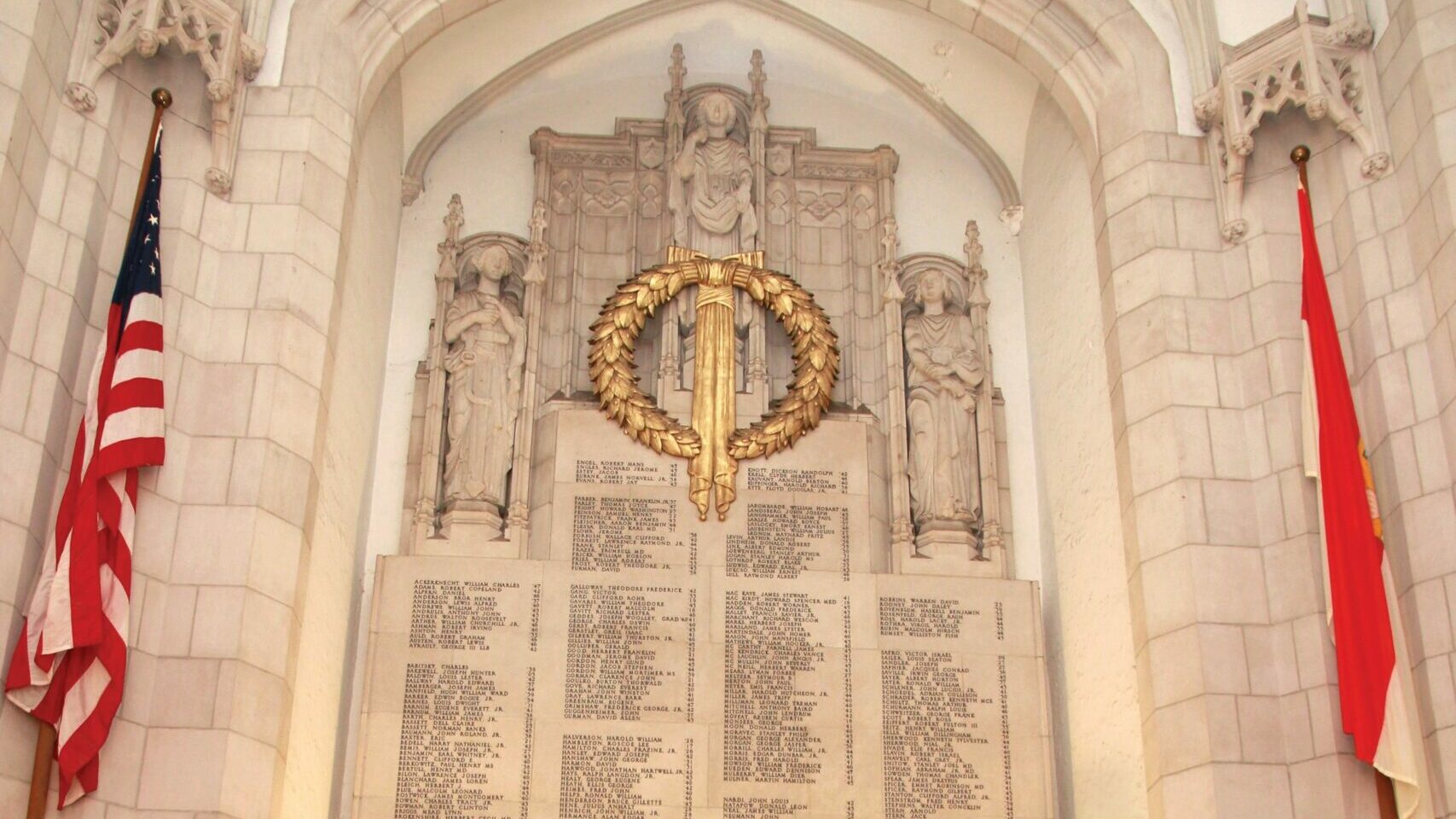
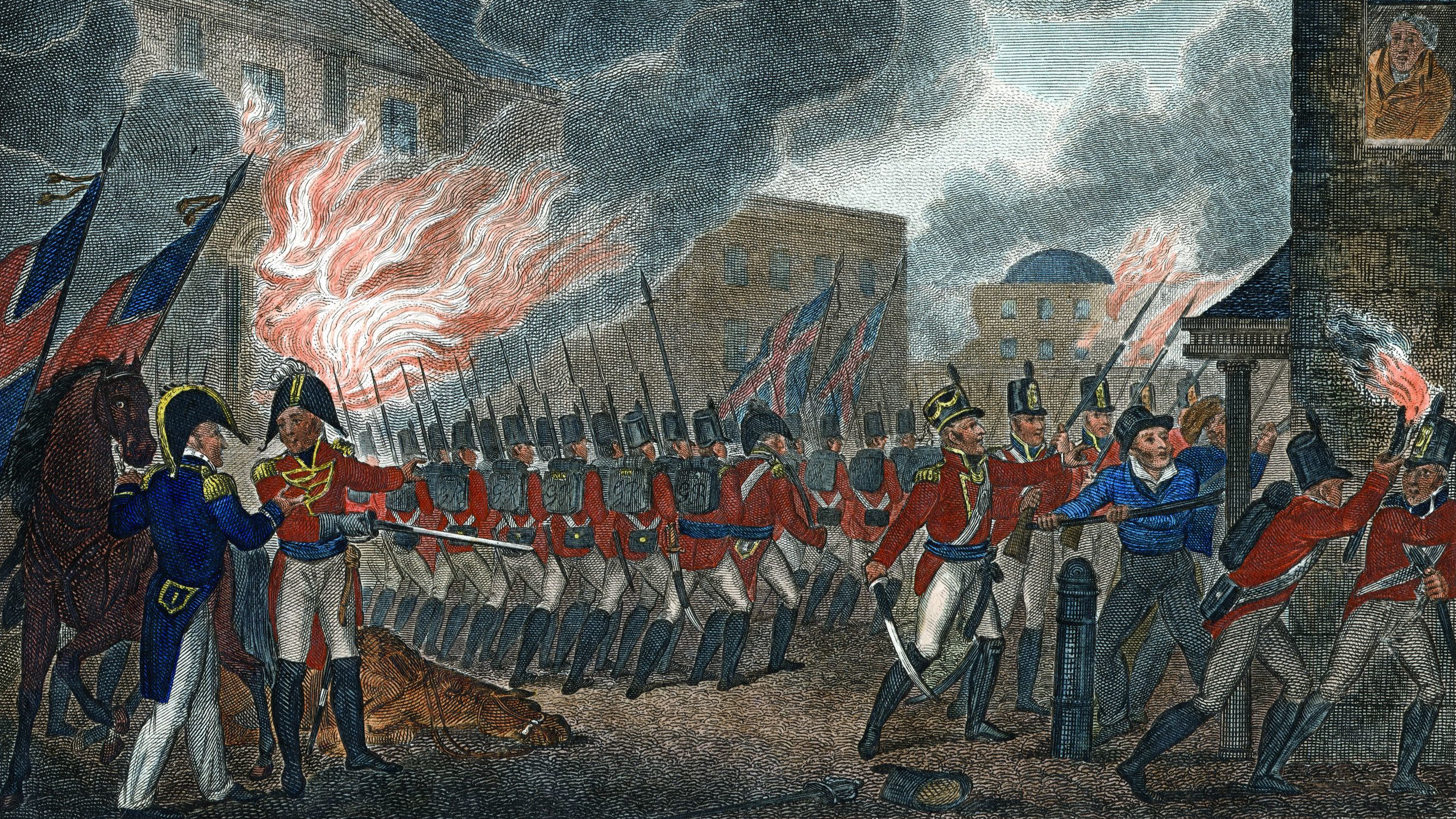
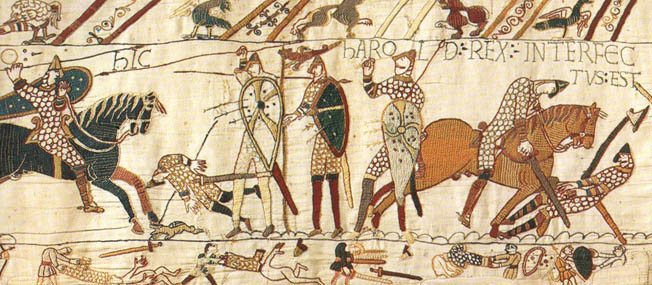

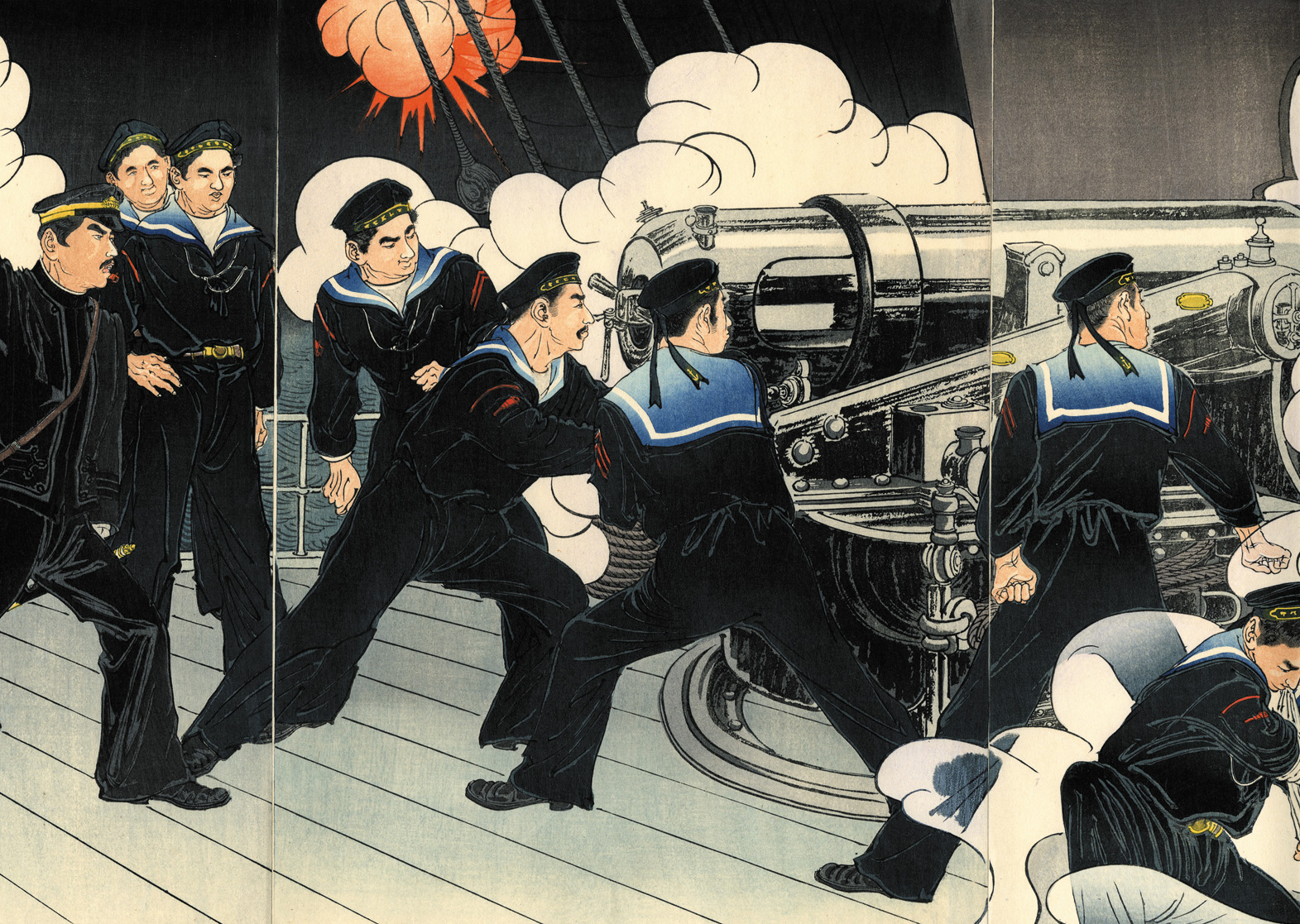
This is the best story I have ever read on this site. Made me feel like I was also flying that mission. Hope everyone on that crew made it back to the States safely. Stories like these are why I stay with the site. Thanks!
I agree with Michael- the details of the mission had my heart pumping- the sudden destruction to the B17s at the end of the bomb run clarify the hazards these men faced and the bravery to get up and do it again and again- real hero’s.
Totally agree with the other compliments. Very well done. Thanks to the author for putting us right there.